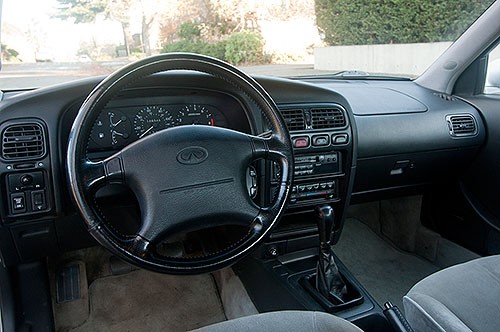Proto-Four-Door Coupe?
The Infiniti J30

The more things change…
At the time it was introduced for the 1993 model year, the major complaint directed at the Infiniti J30 was its puny rear seat volume. One glance at the car reveals its manufacturer obviously prioritized style over function, what with its delicately tapered haunches and miniscule trunk.
Nowadays the “four-door coupe” styling trend, sparked by the introduction of the first-generation Mercedes CLS, is going strong. We’ve seen a whole slew of imitators from the Audi A7 to the BMW 6-Series Gran Coupe and even the Volkswagen CC, and although their barely-usable rear seat space is mentioned, it’s hardly a deal-breaker the way it seemed to be for the unloved J30.

So why didn’t the J30 catch on? Did luxury car buyers overwhelmingly prioritize interior space over style in the mid-’90s in a way they no longer do? Was the buying public so soured on Infiniti’s awful marketing campaign for the brand flagship Q45 (notoriously not even showing images of the car) that the bad vibes overtook its smaller stablemate as well?
Or perhaps the car wasn’t radical enough? For all its swoopy styling, the J30 retains the overall proportions of a traditional 4-door in the way the later CLS doesn’t, not to mention the fact that the Mercedes car has a great whacking V8 under the hood to prove it’s got the moves to back up its looks. The J30, by contrast, was fitted with a 210-hp variant of Nissan’s VG 3.0l V6 engine—a pleasant enough engine, and routing power to the rear wheels no less, but nothing to write home about.

So, combine styling that was just a touch too conservative, merely adequate power and dynamic ability as well as the still-uncertain prestige of a luxury brand still finding its footing in the marketplace, and the reasons behind the J30’s failure to gain a foothold in its target market become clearer.
Still, the fact remains that it is RWD, does have quite a nice engine and is very pretty to behold—those three qualities explain my enduring soft spot for the J30. And I do think Infiniti should receive more credit for creating the first luxury sedan with a styling/function priority tradeoff closely in line with that of the more recent crop of fashion-forward four-doors.
Image credits: edmunds.com, carsnative.com, theautochannel.com










